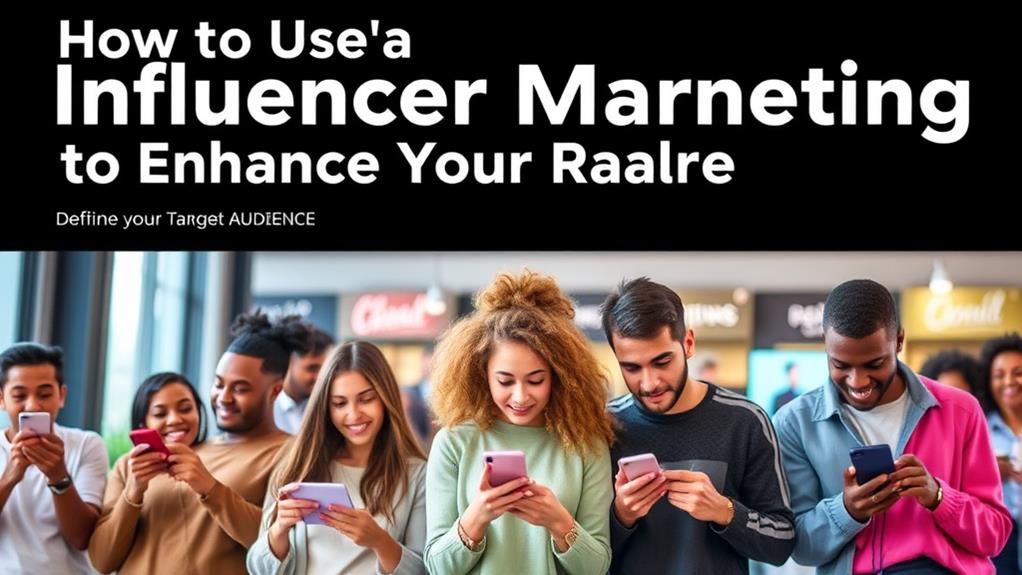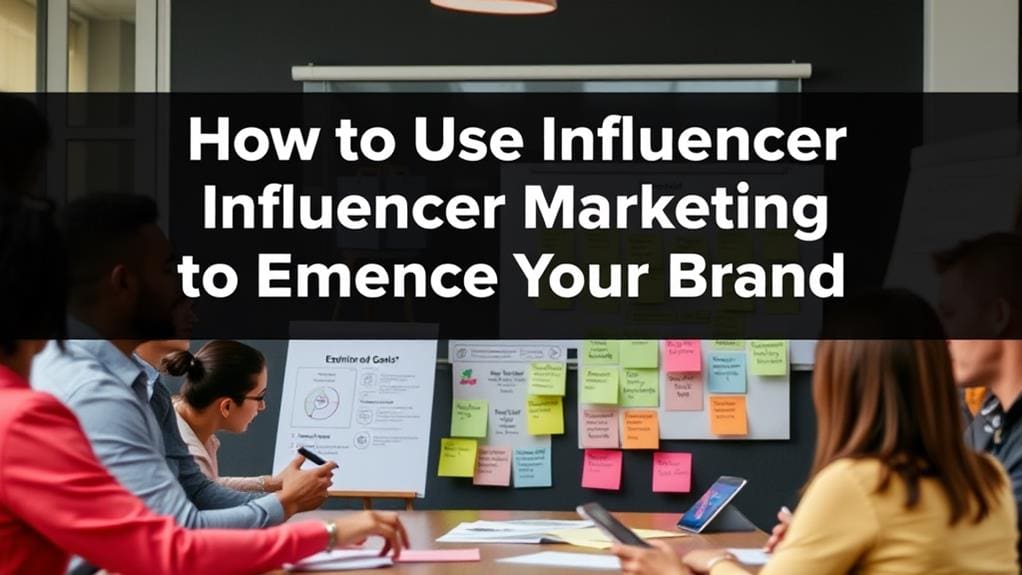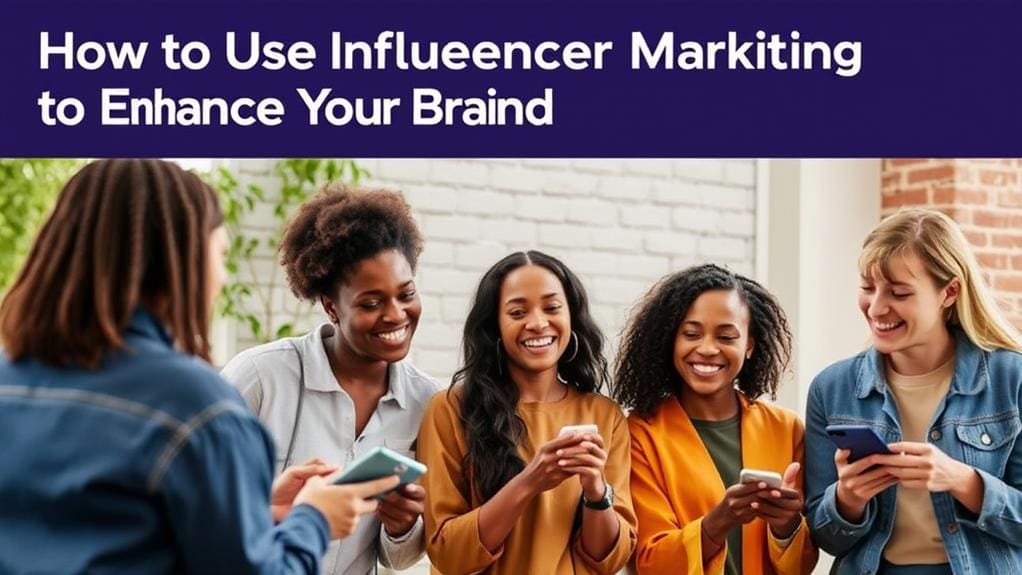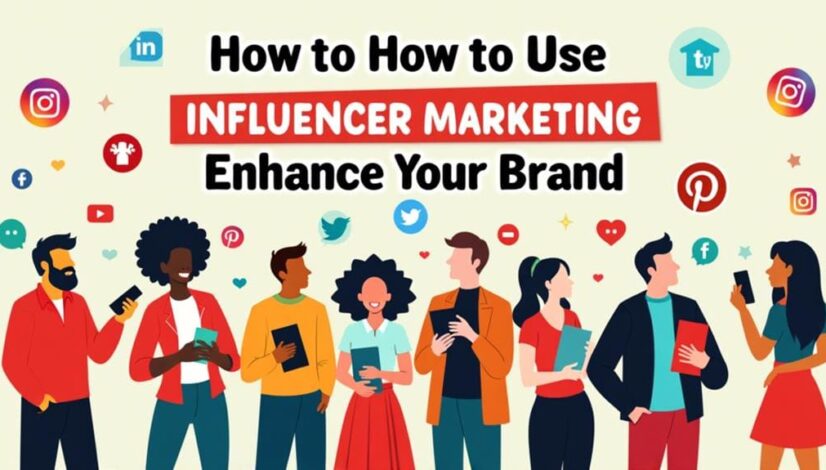How to Use Influencer Marketing to Enhance Your Brand
To enhance your brand through influencer marketing, begin by defining your target audience for tailored messaging. Select influencers whose values align with your brand to foster authenticity and connect meaningfully. Establish clear objectives to measure performance, focusing on metrics like engagement rates and conversions. Develop engaging content that resonates emotionally with the audience, utilizing visual storytelling and interactive elements. Cultivate long-term relationships with influencers to build trust and advocacy. Finally, continuously adapt your strategies based on audience engagement and feedback for ideal effectiveness. This approach lays a solid foundation for impactful influencer marketing that can greatly elevate your brand presence. Additional insights await discovery.
Key Takeaways
- Define your target audience through demographic and psychographic analysis to tailor messaging and improve campaign relevance.
- Choose influencers whose values align with your brand for authentic partnerships that resonate with their followers.
- Establish clear goals and measurable objectives to track the effectiveness of your influencer marketing campaign.
- Develop engaging, multimedia content that captures attention and encourages audience participation through compelling calls-to-action.
- Foster long-term relationships with influencers to build trust, enhance brand credibility, and promote genuine advocacy for your products.
Define Your Target Audience

Understanding your target audience is crucial for the effectiveness of any influencer marketing campaign, as it consistently informs strategic decisions. A thorough approach to audience segmentation allows brands to identify distinct groups within their target market, facilitating tailored messaging that resonates with each segment. This analytical method guarantees that marketing efforts are not only efficient but also effective in driving engagement and conversions.
Demographic analysis serves as an important tool in this segmentation process, providing insights into age, gender, income, education, and geographic location. By examining these variables, brands can develop a nuanced understanding of who their potential customers are and what drives their purchasing decisions. For instance, a beauty brand targeting millennials may find that Instagram influencers resonate more than YouTube personalities, shaping their influencer selection strategy.
Furthermore, understanding psychographics—values, interests, and lifestyles—complements demographic analysis, offering a holistic view of the audience. This dual approach enables brands to craft highly relevant content, making sure that the influencer's voice aligns with the values and desires of the target audience.
Ultimately, defining your target audience through meticulous audience segmentation and demographic analysis not only enhances the relevance of your influencer marketing campaigns but also maximizes your return on investment. Strategic alignment between your brand and the influencer's audience fosters authenticity, paving the way for deeper connections and long-term brand loyalty.
Choose the Right Influencers
Selecting the right influencers is a pivotal step in ensuring the success of your influencer marketing campaign. The alignment between your brand and the influencer's persona, values, and audience can greatly impact influencer credibility and, consequently, the effectiveness of your campaign. It is essential to undertake a meticulous vetting process, evaluating potential influencers not only by their follower count but also by the quality of their audience engagement.
Influencer credibility emerges as a cornerstone of effective marketing partnerships. Influencers who are perceived as authentic and trustworthy will foster a deeper connection with their followers, which can translate into higher conversion rates for your brand. Analyze their previous collaborations and the feedback they receive to gauge their influence and authenticity. An influencer with a loyal following that actively engages with their content can amplify your messaging far more effectively than one with a larger but disengaged audience.
Furthermore, consider the niche relevance of influencers in relation to your target market. An influencer who specializes in your industry will have a more engaged and receptive audience, enhancing the potential for meaningful interactions.
Evaluating their content style and engagement metrics, such as likes, comments, and shares, will provide insight into their ability to foster genuine discussions around your brand.
Establish Clear Goals

Establishing clear goals is essential for effective influencer marketing, as it provides a roadmap for success.
By defining your target audience, you guarantee that your campaign resonates with the right demographics, maximizing engagement and relevance.
Additionally, setting measurable objectives allows for precise evaluation of campaign performance, enabling data-driven adjustments to optimize results.
Define Target Audience
Defining your target audience is an essential step in crafting an effective influencer marketing strategy. This foundational element guarantees that your marketing efforts resonate with the right individuals, maximizing engagement and conversion.
Begin by employing audience segmentation techniques to identify distinct groups within your broader market. Consider demographic factors such as age, gender, and location, but don't overlook the importance of psychographic profiling. This deeper analysis explores the values, interests, and behaviors of your potential customers, allowing you to tailor your messaging and approach.
Once you have segmented your audience, assess which influencers align with each segment's characteristics. This strategic alignment is critical; the effectiveness of influencer marketing hinges on authenticity and relatability.
An influencer who resonates with a specific psychographic profile can dramatically enhance your brand's visibility and credibility.
Set Measurable Objectives
Setting measurable objectives is a vital component of any successful influencer marketing strategy, as it provides a clear framework for evaluating performance and driving results. Establishing these objectives allows brands to create specific, quantifiable goals that align with broader marketing initiatives.
By defining influence metrics—such as engagement rates, reach, and conversions—marketers can assess the effectiveness of their campaigns and make informed adjustments.
To guarantee that objectives are actionable, it is essential to set campaign benchmarks that reflect industry standards and past performance. These benchmarks serve as reference points, enabling brands to gauge their progress and identify areas for improvement. For instance, if the objective is to increase website traffic through influencer partnerships, a measurable goal might be to achieve a 20% increase in unique visitors over a three-month period.
Furthermore, regularly tracking these influence metrics against established benchmarks fosters accountability and transparency within the marketing team. This strategic approach not only enhances the overall effectiveness of influencer campaigns but also facilitates the cultivation of long-term relationships with influencers, ultimately resulting in a more substantial brand presence in the market.
Develop Engaging Content
To capture the attention of your target audience in the crowded digital landscape, developing engaging content is paramount. Within the sphere of influencer marketing, the content you create must not only resonate with your audience but also leverage the unique strengths of your chosen influencers.
Utilizing visual storytelling can greatly enhance the emotional connection between your brand and its audience, as it allows for a narrative that is both relatable and memorable.
Moreover, incorporating interactive content can elevate engagement levels by inviting the audience to participate actively in the experience. This two-pronged approach fosters a deeper relationship with potential customers, making them more likely to engage with your brand.
Key strategies for developing engaging content include:
- Utilizing multimedia elements: Combine images, videos, and infographics to create a rich storytelling experience.
- Creating polls and quizzes: Encourage audience participation, fostering a sense of community and connection.
- Highlighting user-generated content: Showcase testimonials and stories from your customers to build authenticity and trust.
- Implementing compelling calls-to-action: Guide your audience towards the next step, whether it be visiting your website or engaging with a social media post.
Foster Authentic Partnerships

To maximize the impact of influencer marketing, brands must prioritize the alignment of values and goals with their chosen influencers.
Establishing genuine connections fosters long-term relationships that not only resonate with audiences but also enhance brand credibility.
Align Values and Goals
Building authentic partnerships in influencer marketing hinges on the alignment of values and goals between brands and influencers. This alignment is vital for fostering brand authenticity and guaranteeing that campaigns resonate deeply with target audiences.
When both parties share missions, they can create content that not only promotes products but also conveys mutual beliefs and aspirations, enhancing credibility and engagement.
To achieve this, consider the following strategies:
- Identify Core Values: Clearly define your brand's principles and confirm the influencer embodies them.
- Evaluate Audience Overlap: Analyze whether the influencer's audience aligns with your target demographic, promoting a cohesive message.
- Collaborate on Content: Involve influencers in the creative process, allowing their authentic voice to shine through, which fosters trust among followers.
- Set Common Goals: Establish measurable objectives that both parties aim to achieve, such as increasing brand awareness or driving conversions.
Build Long-Term Relationships
Fostering authentic partnerships in influencer marketing requires a strategic commitment to building long-term relationships that extend beyond single campaigns. This approach emphasizes relationship nurturing, which is essential for cultivating a network of influencers who resonate with your brand's ethos and audience.
By investing in these relationships, brands can create a collaborative environment that encourages influencers to advocate genuinely for their products or services.
Trust building is paramount in this process. Influencers who feel valued and respected are more likely to produce authentic content that aligns with their followers' interests and your brand's mission. This not only enhances credibility but also fosters loyalty among the influencer's audience, translating into sustained engagement for your brand.
Moreover, long-term partnerships allow for deeper insights into the influencer's audience, enabling more strategic content that resonates on a personal level. By involving influencers in product development or exclusive previews, brands can create a sense of ownership that further strengthens their relationship.
Ultimately, nurturing these authentic connections leads to greater brand affinity, higher conversion rates, and a competitive advantage in the increasingly crowded marketplace. Embracing this strategy guarantees that influencer marketing becomes a cornerstone of your brand's growth trajectory.
Measure Campaign Success
Success in influencer marketing campaigns can often feel elusive, but it is essential to establish clear metrics to evaluate their effectiveness. Measuring campaign success goes beyond merely counting likes and shares; it requires a strategic approach that aligns with your brand's objectives.
By utilizing robust campaign metrics, you can gain insightful data that informs future strategies and optimizes your return on investment.
To effectively measure the success of your influencer marketing initiatives, consider the following key metrics:
- Engagement Rate: Analyze interactions such as comments, likes, and shares to gauge audience interest and involvement.
- Reach and Impressions: Assess how many individuals saw your content, reflecting the overall visibility and awareness generated through the campaign.
- Conversion Tracking: Evaluate the number of users who completed desired actions, such as signing up for newsletters or making purchases, as a direct result of your campaign.
- Return on Investment (ROI): Calculate the financial return relative to the cost of the campaign, providing a clear picture of its profitability.
Implementing these metrics not only quantifies your campaign's impact but also offers an extensive view of its overall success.
By mastering the art of measurement, brands can refine their influencer marketing strategies, ensuring alignment with their broader business goals and fostering sustainable growth.
Ultimately, a data-driven approach empowers brands to make informed decisions and elevate their influencer marketing efforts to new heights.
Adapt and Optimize Strategies

Adapting and optimizing your influencer marketing strategies is essential for maintaining relevance and effectiveness in an ever-evolving digital landscape. As consumer preferences shift and new platforms emerge, brands must be agile in their approach while leveraging data-driven insights to refine their methods.
A critical aspect of this process is platform selection. Identifying the right channels where your target audience congregates can dramatically enhance engagement and conversion rates. For instance, utilizing visual platforms like Instagram and TikTok may be more effective for brands targeting younger demographics, whereas LinkedIn could serve well for B2B initiatives.
Evaluating each platform's unique features and audience characteristics will enable you to align your influencer partnerships accordingly.
Moreover, audience engagement should remain at the forefront of your strategy. Continuously measuring engagement metrics—such as likes, comments, shares, and click-through rates—can provide invaluable insights into what resonates with your audience.
Use this data to iterate on content formats, messaging, and influencer selection. Engaging directly with your audience through polls, questions, or live sessions can also cultivate a deeper connection and foster brand loyalty.
Frequently Asked Questions
How Do I Find the Right Influencer Marketing Platform?
Finding the right influencer marketing platform necessitates a strategic approach, emphasizing influencer vetting and platform features.
Begin by evaluating the platform's database of influencers, ensuring it aligns with your brand's target audience. Evaluate the vetting processes for authenticity and engagement metrics to avoid misalignment.
Additionally, consider essential features such as campaign management tools and analytics support, which can facilitate performance tracking and optimization, ultimately enhancing your influencer marketing outcomes.
What Budget Should I Allocate for Influencer Marketing?
Determining an appropriate budget for influencer marketing entails a strategic budget breakdown that accounts for various influencer tiers.
Begin by allocating funds based on the reach and engagement levels of influencers, from micro to macro.
Consider a diversified approach, ensuring that a portion of the budget is reserved for testing different tiers.
Additionally, factor in campaign goals, content creation costs, and potential ad spend, ensuring alignment with overall marketing objectives for ideal results.
Can Micro-Influencers Be as Effective as Macro-Influencers?
The effectiveness of micro-influencers compared to their macro counterparts has garnered significant attention.
Research indicates that micro-influencers often yield higher audience engagement due to their perceived authenticity and niche focus. Their ability to foster genuine connections fosters loyalty, which can translate into impactful brand advocacy.
Consequently, brands may find micro-influencer effectiveness aligns strategically with targeted outreach, enhancing overall marketing efficacy while optimizing budget allocation for sustained engagement and measurable results.
How Long Should an Influencer Campaign Last?
Determining the ideal campaign duration is critical for maximizing influencer engagement and achieving strategic objectives.
Typically, a campaign should span four to six weeks to allow adequate time for content creation, audience interaction, and performance analysis.
This timeframe facilitates sustained visibility and fosters deeper connections between the influencer and their audience.
What Legal Considerations Should I Keep in Mind for Influencer Partnerships?
Steering influencer partnerships can sometimes feel like deciphering hieroglyphics—legal hieroglyphics, no less.
However, understanding disclosure guidelines is essential to maintain transparency and trust. Clearly outline contract terms to define expectations and protect both parties.
This strategic approach not only safeguards your brand but also enhances credibility in the eyes of consumers. By prioritizing these legal considerations, you can craft partnerships that are as fruitful as they are compliant.
Conclusion
In summary, the strategic implementation of influencer marketing possesses the potential to catapult a brand to unprecedented heights of visibility and consumer engagement. By meticulously defining target audiences, selecting appropriate influencers, and establishing clear objectives, brands can create compelling content that resonates authentically. The cultivation of genuine partnerships, coupled with rigorous measurement and optimization of campaigns, guarantees sustained success. Ultimately, harnessing influencer marketing is not merely an option; it is an imperative for brands seeking to thrive in today's competitive landscape.




